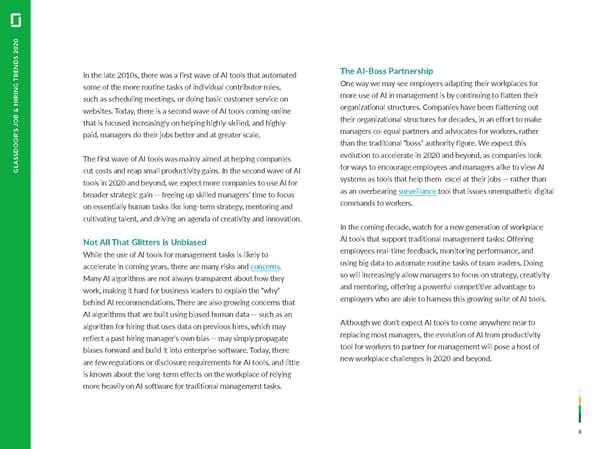TRENDS 2020 In the late 2010s, there was a first wave of AI tools that automated The AI-Boss Partnership some of the more routine tasks of individual contributor roles, One way we may see employers adapting their workplaces for such as scheduling meetings, or doing basic customer service on more use of AI in management is by continuing to flatten their websites. Today, there is a second wave of AI tools coming online organizational structures. Companies have been flattening out JOB & HIRING that is focused increasingly on helping highly-skilled, and highly- their organizational structures for decades, in an effort to make paid, managers do their jobs better and at greater scale. managers co-equal partners and advocates for workers, rather than the traditional “boss” authority figure. We expect this The first wave of AI tools was mainly aimed at helping companies evolution to accelerate in 2020 and beyond, as companies look for ways to encourage employees and managers alike to view AI GLASSDOOR'S cut costs and reap small productivity gains. In the second wave of AI tools in 2020 and beyond, we expect more companies to use AI for systems as tools that help them excel at their jobs — rather than broader strategic gain -- freeing up skilled managers’ time to focus as an overbearing surveillance tool that issues unempathetic digital on essentially human tasks like long-term strategy, mentoring and commands to workers. cultivating talent, and driving an agenda of creativity and innovation. In the coming decade, watch for a new generation of workplace Not All That Glitters is Unbiased AI tools that support traditional management tasks: Offering While the use of AI tools for management tasks is likely to employees real-time feedback, monitoring performance, and accelerate in coming years, there are many risks and concerns. using big data to automate routine tasks of team leaders. Doing Many AI algorithms are not always transparent about how they so will increasingly allow managers to focus on strategy, creativity work, making it hard for business leaders to explain the “why” and mentoring, offering a powerful competitive advantage to behind AI recommendations. There are also growing concerns that employers who are able to harness this growing suite of AI tools. AI algorithms that are built using biased human data — such as an algorithm for hiring that uses data on previous hires, which may Although we don’t expect AI tools to come anywhere near to reflect a past hiring manager’s own bias -- may simply propagate replacing most managers, the evolution of AI from productivity biases forward and build it into enterprise software. Today, there tool for workers to partner for management will pose a host of are few regulations or disclosure requirements for AI tools, and little new workplace challenges in 2020 and beyond. is known about the long-term effects on the workplace of relying more heavily on AI software for traditional management tasks. 8
 Job & Hiring Trends Page 7 Page 9
Job & Hiring Trends Page 7 Page 9